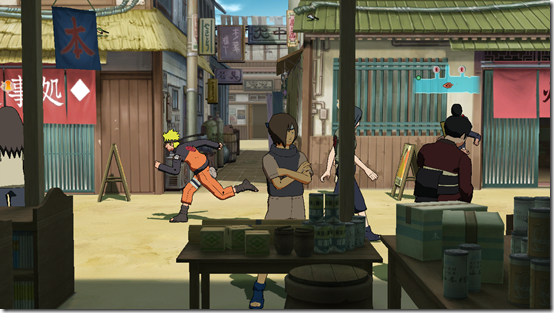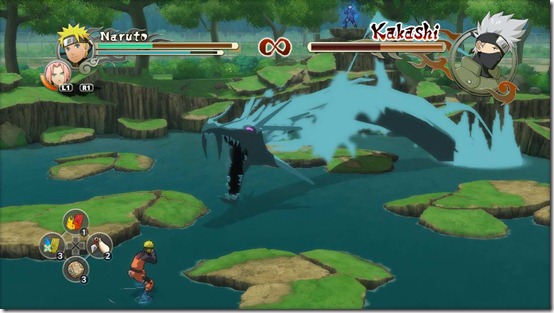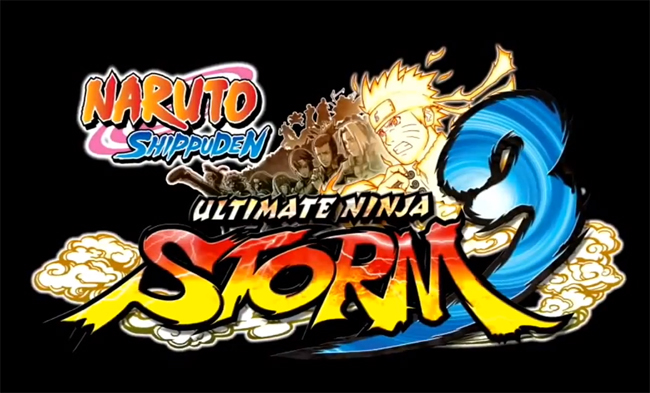So I wrote about Naruto Shippuden: Ultimate Ninja Storm (number 2, to be specific) before. I’ve only actually played one, but it gave me a pretty good sense of the whole just from a few hours of play.
If you’re read anything on this site, you’ll know that my preference does not lay within the narrative based game. This comes from, among other reason, my focus on the mechanics of said games and whether they inspire a player to continue to play in order to atttain mastery of said mechanics. It’s a far better way to play, becomes more immersive over time, and frankly makes certain games produce that ever-elusive “replay value” that so much virtual entertainment creates through mental tricks and traps. For the latter, just look at any MMO on the planet or the constant kleptomania of the recent glut of open-world games (the Batman Arkham series and Assassin’s Creed feel especially prone to force you into the gathering of useless collectibles).
Naruto and its “anime fighting game” ilk, thank God, don’t force you to collect stuff most of the time. However, most fighting games don’t retain so much a focus on the Story Mode like them. I know, I know – that’s the whole appeal of this weird subgenre. People like characters in their favorite anime, or they like the story and want to participate in that story. Who hasn’t seen a fight sequence in Dragon Ball Z and felt that excitement…spread between six episodes? The game takes out all that downtime immediately, and lets you form your own dream matches. Frieza versus Broly? Adult Trunks versus Young Gohan? Sure! Why not!? The appeal’s probably the same for any Naruto fan worth their weight in salt like Justin Fox.
But, and here’s where I find the problem, every one locks most of the characters behind the story mode. If you wanted to jump into the game immediately and play as whatever Naruto character from the gigantic roster, prepare for disappointment. No, you must play the Story and you must unlock them only through here. Even with online play, that’s a crippling entry-point for newcomers. I fonnd themselves drawn into a magnificent display of graphical prowess – seriously, they all look amazing on PS3 with surround sound -only to discover that CyberConnect 2 doesn’t want me to play online. OH NO – SON, if you want your Naruto fighting action, you’d better play this half-baked RPG with incessant tutorials.
Seriously? Why? Please explain WHY we need this.

To contrast: Dragon Ball Z Budokai 3 (and for reference ALL the original series of Budokai on PS2) presented a linear story mode. It played great, it looked great, and you found yourself in all the highlights of the series and film offshoot. One felt cool precisely because they’re placed into the IMPORTANT events of the story. I don’t want to figure out what Goku eats or his daily habits or where he shops for groceries. No, I want to play as Goku, turn Super Saiyan, and go crazy on somebody. If we’re talking multiplayer, I want to go all crazy on you.
I make the contrast simply because Naruto isn’t content with the linear format; instead, you wander around town and do tasks. A tutorial box pops up. Another one pops up. Here’s a shop; there’s another shop. Soon enough, you’re bogged down into details about item usage and quests until your brain explodes. Can you move forward WITHOUT doing these things? No. You need to do at LEAST a few. It’s as if a developer said “let’s make parts of our game that are fun, and parts of the game that aren’t fun at all. Then, we’ll restrict it arbitrarily with the gatekeepers of boring fetch quests.” Is that what happens in the development meeting? Does that pass for content?
Once you get past these time-wasting incoveniences, the fights themselves replicate what you’d see in the anime…except YOU’RE playing them, which remains a lot of fun. The boss battles especially deserve notice for being incredibly cinematic, challenging, revealing of plot details, AND looking quite awesome. It’s hard to top that. Every move feels good and has that proper pause on impact that exacerbates the hit. Every challenger, befitting the game full of ninjas, moves at a lightning fast pace. Tons of visual information appears, from assists to super attacks to teleport parries (I apologize for not knowing the name). I’d call it a more controlled version of Anarchy Reigns, if I could make a comparison, but that’s a good thing!

So why cover your amazing game with all this annoying busywork? Seemingly every game in the modern age does this, from the need to earn kill counts for additional weapons in Call of Duty to the endless quest for collectible knicknacks and nonsense. We call them “extras” or “sidequests” and the like, but the result’s the same in many cases – you just spent five hours collecting a useless thing that gave you a spiffy new costume, a false sense of accomplishment, and a lot of wasted time. But who doesn’t just keep doing this stuff in games, just deferring to the developer that it’ll be worth it in the end?
Perhaps it is a part of our sinful nature to just accept entertainment as it is. Video games, those everpresent sources of fun, might see a variety of definitions, but bottomless amounts of “content” doesn’t equate to meaningful content. I do not want to passively accept the goal; I need the designer to force me to rise to the occasion. We tend to accept it because that remains the easy answer, yet why should we forgive these moments in games where nothing happens? I’m not talking about story or the actual game, but the lull moments. They’re not there for pacing (I could accept it if that were true) in many cases, but to pad the time. They give us an opportunity to sit on the couch and do nothing yet feel like something.
From a Christian perspective, that seems like a whole lot of nonsense. Manipulation into repetive, unchallenging tasks cannot be what we’re made to do. To cite one of the many verses on the subject in the Bible:
6 Go to the ant, O sluggard,
Observe her ways and be wise,
7 Which, having no chief,
Officer or ruler,
8 Prepares her food in the summer
And gathers her provision in the harvest.
9 How long will you lie down, O sluggard?
When will you arise from your sleep?
10 “A little sleep, a little slumber,
A little folding of the hands to rest”—
11 Your poverty will come in like a vagabond
And your need like an armed man.Proverbs 6
Video games train us to think every task within its programmed borders constitutes a “meaningful” task or a contribution to the main goal. We unconsciously accept this, and find ourselves performing menial work in an imaginary world! It almost seems like dreaming of stacking cardboard boxes in a warehouse – what a terrible waste of a dream! And, by association, what a terrible waste of life! Let us play video games where it promote initiative and skill, not passive experiences. Let’s play game that make us think, rather than going through the motions. Let’s play game that motivate us to explore, not out of some predefined achievements or false initiative but real content, full to the brim with engaging and exciting design.
Otherwise, you lose your edge. You get lazy. And in the end, you may find yourself a lazy sluggard in both games and in life.

